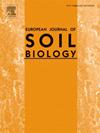The light shifts in ammonia nitrogen affected soil microbial communities with their related dissolved organic matter in the arid region
IF 3.3
2区 农林科学
Q1 ECOLOGY
引用次数: 0
Abstract
Arid and semi-arid climates are vital components of ecosystem, however, the mechanisms by which microorganisms respond to soil dissolved organic matter (DOM) in these regions under the constraint of ammonium nitrogen remain unknown. In this study, we investigated the differences in microbial diversity, composition, abundance, and DOM composition in soils with varying ammonia-nitrogen (NH4+-N) concentrations in arid and semi-arid regions. We also explored the connectivity between the co-occurrence networks of microorganisms and DOM. In high NH4+-N environments, the phyla of soil microorganisms that showed an increase included Anabaena and Thick-walled Bacteria. Moreover, the abundance of microorganisms such as Reyranella, Actinophyfocala, and Arhrobacter also increased. The main metabolic modes of these microorganisms were lysine biosynthesis and D-amino acid metabolism. Metabolites that exhibited elevated levels along with the increase in NH4+-N content included those related to chlorocyclohexane and chlorobenzene degradation, as well as geraniol degradation. NH4+-N was identified as the most significant environmental factor influencing the relationship between microorganisms and DOM. In high-ammonia environments, the number of links, average clustering coefficient, density, and connectivity of the microorganisms and DOM co-occurrence network were significantly higher. This indicates that the co-occurrence network was more complex and stable. In contrast, low NH4+-N environments restricted microbial metabolic processes and altered the DOM composition, leading to a further limitation of microbial activity. This study elucidated the response mechanism of soil microorganisms to DOM under the limitation of NH4+-N in arid and semi-arid regions and emphasized the crucial role of soil NH4+-N concentration in the soil biological cycle. It offers a reference for monitoring soil quality, preventing soil degradation, and maintaining ecological environment and food security.
干旱区氨氮的光移影响了土壤微生物群落及其相关的溶解有机质
干旱和半干旱气候是生态系统的重要组成部分,但这些地区微生物在铵态氮约束下对土壤溶解有机质(DOM)的响应机制尚不清楚。本文研究了干旱和半干旱区不同氨氮(NH4+-N)浓度土壤中微生物多样性、组成、丰度和DOM组成的差异。我们还探索了微生物共现网络与DOM之间的连通性。在高NH4+-N环境下,土壤微生物类群增加的主要有水蓝藻和厚壁细菌。此外,Reyranella、放线藻、Arhrobacter等微生物的丰度也有所增加。这些微生物的主要代谢方式是赖氨酸生物合成和d -氨基酸代谢。随着NH4+-N含量的增加,代谢物水平升高,包括与氯环己烷和氯苯降解相关的代谢物,以及香叶醇降解相关的代谢物。NH4+-N是影响微生物与DOM关系最显著的环境因子。在高氨环境下,微生物和DOM共现网络的链接数、平均聚类系数、密度和连通性显著更高。这说明共现网络更加复杂和稳定。相反,低NH4+-N环境限制了微生物的代谢过程,改变了DOM的组成,进一步限制了微生物的活性。本研究阐明了干旱半干旱区土壤微生物在NH4+-N限制下对DOM的响应机制,强调了土壤NH4+-N浓度在土壤生物循环中的关键作用。为监测土壤质量,防止土壤退化,维护生态环境和粮食安全提供参考。
本文章由计算机程序翻译,如有差异,请以英文原文为准。
求助全文
约1分钟内获得全文
求助全文
来源期刊

European Journal of Soil Biology
环境科学-生态学
CiteScore
6.90
自引率
0.00%
发文量
51
审稿时长
27 days
期刊介绍:
The European Journal of Soil Biology covers all aspects of soil biology which deal with microbial and faunal ecology and activity in soils, as well as natural ecosystems or biomes connected to ecological interests: biodiversity, biological conservation, adaptation, impact of global changes on soil biodiversity and ecosystem functioning and effects and fate of pollutants as influenced by soil organisms. Different levels in ecosystem structure are taken into account: individuals, populations, communities and ecosystems themselves. At each level, different disciplinary approaches are welcomed: molecular biology, genetics, ecophysiology, ecology, biogeography and landscape ecology.
 求助内容:
求助内容: 应助结果提醒方式:
应助结果提醒方式:


